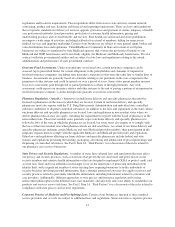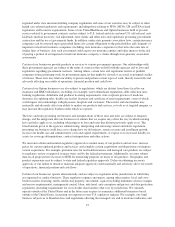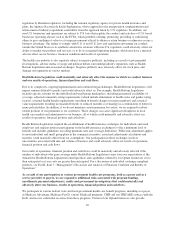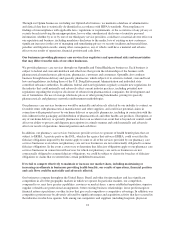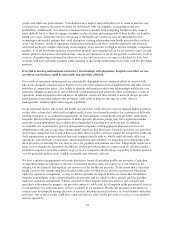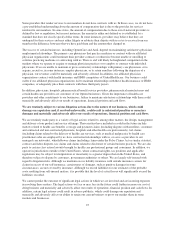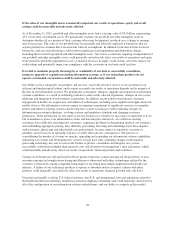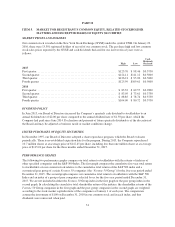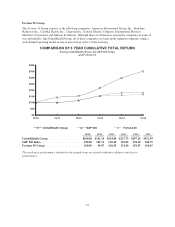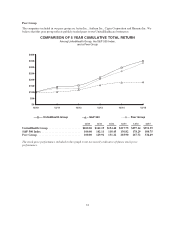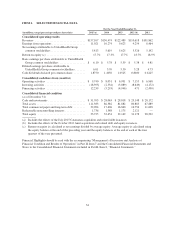United Healthcare 2015 Annual Report Download - page 26
Download and view the complete annual report
Please find page 26 of the 2015 United Healthcare annual report below. You can navigate through the pages in the report by either clicking on the pages listed below, or by using the keyword search tool below to find specific information within the annual report.groups and other care professionals). Consolidation may make it more difficult for us to retain or increase our
customer base, improve the terms on which we do business with our suppliers, or maintain or increase
profitability. Additionally, new direct-to-consumer business models from competing businesses may make it
more difficult for us to directly engage consumers in the selection and management of their health care benefits,
health care usage, and in the effective navigation of the health care system we may be challenged by new
technologies and market entrants that could disrupt our existing relationship with health plan enrollees in these
areas. Our business, results of operations, financial position and cash flows could be materially and adversely
affected if we do not compete effectively in our markets, if we set rates too high or too low in highly competitive
markets, if we do not design and price our products properly and competitively, if we are unable to innovate and
deliver products and services that demonstrate value to our customers, if we do not provide a satisfactory level of
services, if membership or demand for other services does not increase as we expect or declines, or if we lose
accounts with more profitable products while retaining or increasing membership in accounts with less profitable
products.
If we fail to develop and maintain satisfactory relationships with physicians, hospitals and other service
providers, our business could be materially and adversely affected.
Our results of operations and prospects are substantially dependent on our continued ability to contract with
physicians, hospitals, pharmaceutical benefit service providers, pharmaceutical manufacturers and other service
providers at competitive prices. Any failure to develop and maintain satisfactory relationships with health care
providers, whether in-network or out-of-network, could materially and adversely affect our business, results of
operations, financial position and cash flows. In addition, certain activities related to network design, provider
participation in networks and provider payments could result in disputes that may be costly, distract
managements’ attention and result in negative publicity.
In any particular market, physicians and health care providers could refuse to contract, demand higher payments,
or take other actions that could result in higher medical costs, less desirable products for customers or difficulty
meeting regulatory or accreditation requirements. In some markets, certain health care providers, particularly
hospitals, physician/hospital organizations or multi-specialty physician groups, may have significant market
positions or near monopolies that could result in diminished bargaining power on our part. In addition,
accountable care organizations; practice management companies (which aggregate physician practices for
administrative efficiency); and other organizational structures that physicians, hospitals and other care providers
choose may change the way in which these providers interact with us and may change the competitive landscape.
Such organizations or groups of physicians may compete directly with us, which could adversely affect our
operations, and our results of operations, financial position and cash flows by impacting our relationships with
these providers or affecting the way that we price our products and estimate our costs, which might require us to
incur costs to change our operations. In addition, if these providers refuse to contract with us, use their market
position to negotiate favorable contracts or place us at a competitive disadvantage, our ability to market products
or to be profitable in those areas could be materially and adversely affected.
We have capitation arrangements with some physicians, hospitals and other health care providers. Capitation
arrangements limit our exposure to the risk of increasing medical costs, but expose us to risk related to the
adequacy of the financial and medical care resources of the health care provider. To the extent that a capitated
health care provider organization faces financial difficulties or otherwise is unable to perform its obligations
under the capitation arrangement, we may be held responsible for unpaid health care claims that should have
been the responsibility of the capitated health care provider and for which we have already paid the provider,
under the capitation arrangement. Further, payment or other disputes between a primary care provider and
specialists with whom the primary care provider contracts could result in a disruption in the provision of services
to our members or a reduction in the services available to our members. Health care providers with whom we
contract may not properly manage the costs of services, maintain financial solvency or avoid disputes with other
providers. Any of these events could have a material adverse effect on the provision of services to our members
and our operations.
24


